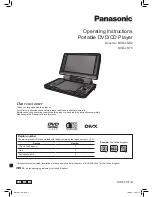
10-2 5100 ES Model II/III Portable Radio Operating Manual
December 2006
Secure Communication (Encryption)
10.1.2 AES (Advanced Encryption Standard)
A new encryption standard called AES is replacing DES-OFB encryption on digital (P25)
channels. It uses a 128-, 192-, or 256-bit encryption key instead of the 64-bit key used with
DES. EFJohnson radios currently support only 256-bit AES keys. The type of encryption
(DES or AES) is determined by the type of encryption key that is loaded (see Section
10.2), and not by the PC Configure programming software. AES encryption, like DES
encryption, is an optional radio feature that must be purchased and then enabled at the
factory.
Note
The 51SL ES Series radios do not support AES encryption.
10.1.3 Encryption Available With Various Channel Types
Analog Channels
- On analog conventional and SMARTNET/SmartZone channels, DES
encryption provides secure communication.
Digital Channels
- On digital Project 25 and SMARTNET/Smart Zone channels, the
DES-OFB or AES-OFB protocol is used.
10.1.4 FIPS and Non-FIPS Modes
FIPS 140-2 is a Federal Information Processing Standard for encrypted radios used by the
Federal Government. This standard specifies Federal security requirements for
cryptographic modules for a wide range of applications and environments.
10.2 Encryption Keys
An encryption key is a cryptographic variable that is required by the encryption algorithm
to encrypt and decrypt voice or data. To maintain system security, these keys must be
protected from disclosure and also periodically replaced or updated.
With the AES and DES encryption used by EFJohnson radios (see Section 10.1), the same
encryption key is used by both the encrypting (sending) and decrypting (receiving) radio.
AES encryption keys are generated from a string of 64 hexadecimal characters, and DES
keys are generated from a string of 16 hexadecimal characters. Another four hexadecimal
characters are used to specify the key ID. Multiple keys can be loaded into a radio using
OTAR or manual loading.
When an encrypted message is transmitted, the encryption Algorithm ID (ALID) and key
ID (KID) are usually included in the message. This tells the receiving radio which key and
algorithm must be used to decrypt the message.
Содержание 5100 ES II
Страница 2: ......
Страница 4: ......
Страница 6: ......
Страница 14: ...viii 5100 ES Model II III Portable Radio Operating Manual December 2006 List of Figures continued Figure Page...
Страница 16: ...viii 5100 ES Model II III Portable Radio Operating Manual December 2006 List of Tables continued Table Page...
Страница 24: ...1 4 5100 ES Model II III Portable Radio Operating Manual December 2006 Features...
Страница 88: ...5 28 5100 ES Model II III Portable Radio Operating Manual December 2006 Conventional Mode Features...
Страница 118: ...8 4 5100 ES Model II III Portable Radio Operating Manual December 2006 Determining Available Options...
Страница 122: ...9 4 5100 ES Model II III Portable Radio Operating Manual December 2006 Password Description...
Страница 143: ......
















































